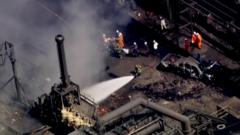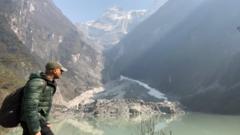Authorities in Lahore, home to about 13 million people, have declared a public health emergency as the city grapples with unprecedented levels of air pollution this week, resulting in significant health risks for residents.
Drastic actions have been put into place as air quality plummeted, forcing officials in Punjab province to shut down primary schools and advise that all secondary schools remain closed until at least mid-November. The alarming spike in pollution resulted in Lahore being ranked as having the worst air quality in the world according to monitoring agencies, which report hazardous air quality levels that residents have described as suffocating.
“Breathing feels like a chore,” expressed Rahat Hussain, a local teacher, noting that even indoors, the toxic haze found its way into homes. To combat the public health crisis, authorities have mandated the closure of non-essential businesses, including barbecue restaurants, and imposed restrictions on polluting vehicles and industries that contribute to the smog.
The provincial government has also issued advisories recommending that residents wear masks outdoors as they navigate daily life amid the choking haze that authorities expect to continue for at least the next week. Over 70 million people in Punjab province are affected by the situation, with multiple health agencies reporting hundreds of hospitalizations due to respiratory illness linked to air pollution.
“This is a developing situation that we are monitoring closely,” stated Marriyum Aurangzeb, a senior provincial minister, emphasizing the need for immediate action to address the public health risks posed by worsening air quality. With stay-at-home orders affecting half of the workforce in the city, citizens are left to cope with the crippling impacts of one of Pakistan’s most significant environmental health challenges in recent memory.
Drastic actions have been put into place as air quality plummeted, forcing officials in Punjab province to shut down primary schools and advise that all secondary schools remain closed until at least mid-November. The alarming spike in pollution resulted in Lahore being ranked as having the worst air quality in the world according to monitoring agencies, which report hazardous air quality levels that residents have described as suffocating.
“Breathing feels like a chore,” expressed Rahat Hussain, a local teacher, noting that even indoors, the toxic haze found its way into homes. To combat the public health crisis, authorities have mandated the closure of non-essential businesses, including barbecue restaurants, and imposed restrictions on polluting vehicles and industries that contribute to the smog.
The provincial government has also issued advisories recommending that residents wear masks outdoors as they navigate daily life amid the choking haze that authorities expect to continue for at least the next week. Over 70 million people in Punjab province are affected by the situation, with multiple health agencies reporting hundreds of hospitalizations due to respiratory illness linked to air pollution.
“This is a developing situation that we are monitoring closely,” stated Marriyum Aurangzeb, a senior provincial minister, emphasizing the need for immediate action to address the public health risks posed by worsening air quality. With stay-at-home orders affecting half of the workforce in the city, citizens are left to cope with the crippling impacts of one of Pakistan’s most significant environmental health challenges in recent memory.






















